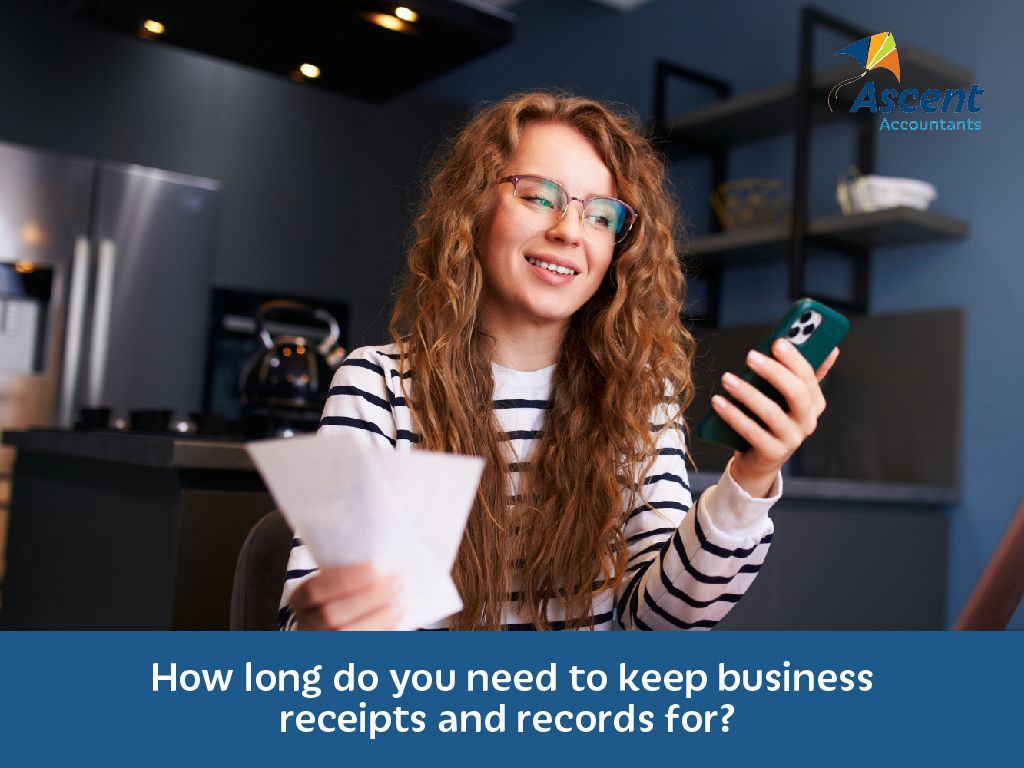How long do you need to keep business receipts and records for?

Record-keeping is an essential part of running your business — it’s important to understand the record-keeping requirements so you can meet legal tax, super and registration obligations for your business. Not only does it make tax time easier, these records help you make informed business decisions backed by data. Keeping accurate records helps you (and banks and lenders) see how your business is going, track income and expenses, and makes your tax return simpler for your registered tax or BAS agent.
What business records you need to keep.
Records you need to keep include receipts and any other evidence of sales and purchases (such as warranties or ownership documents) you made for your business. This might include equipment such as a phone, laptop, or tools, land and property purchases, vehicles, and other assets. You’ll also need to note all records relating to tax returns, activity statements, fringe benefits tax (FBT) returns, contributions to employee super, tax invoices, wage and salary records, and documents about GST.
Payments or amounts you receive.
If you receive income or other payment amounts you need to declare in your tax return, you need records that show the amounts. You may need to provide the ATO with a copy of the records if they review a return you lodge.
For salary, wages, allowances, government payments or pensions and annuities you receive, your records may include:
- Your income statement if your employer reports to the ATO through single touch payroll (STP).
- Your PAYG payment summary — individual non-business.
- Your PAYG payment summary — superannuation income stream.
- A signed letter or statement from your payer, that provides the same information as an income statement or payment summary.
For assessable investment income from interest, dividend and distributions from managed funds, your records may include:
- Interest, dividends or distributions statements.
- Standard Distribution Statement (SDS) and Attribution managed investment trust member annual (AMMA) statement, that shows the amount of your distribution, the amount of any primary production or non-primary production income, any capital gains or losses, any foreign income and your share of any credits.
Deductible expenses.
If you claim a deduction for a deductible expense, you must have records. Examples include the cost of managing your tax affairs or gifts and donations you make to a deductible gift recipient. For most expenses, you need to provide a receipt or similar document as evidence.
Work-related expenses.
If you claim a deduction for a work-related expense, you must have records of those expenses that show you spent the money and how that expense directly relates to earning income. To do this, you need a record that shows private and work-related use, and how you calculate the amount you claim as a deduction. This might include expenses for vehicles and transport, travel, clothing and dry-cleaning, mobile and internet use, and even meals.
Investments and assets.
If you acquire a capital asset, you’ll make a capital gain or capital loss if you later sell the asset. To ensure you don’t pay more tax than necessary, keep accurate records from when you buy the asset. This may include income you receive from an investment property or dividends from shares.
How to keep records of income and expenses.
Written evidence of your income or expenses can be paper-based or electronic — most people find electronic methods of recordkeeping easier. For most expenses, you need a receipt or similar document from the supplier (without it, it will be very difficult to support any expense claims you make in your tax return).
If a receipt is lost, destroyed, or difficult to obtain for some reason, an acceptable record will have the following data:
- The name or business name of the supplier.
- The amount of the expense or cost of the asset.
- The nature of the goods or services.
- The date you buy the goods or services.
- The date the document was produced.
The importance of keeping records.
Australia's tax system relies on self-assessment. This means that, in most cases, the ATO accepts that the information you provide is accurate. However, if they review your tax return and you don't have evidence to support claims for a deduction, your claims will be taken off your tax return.
Keeping records helps you and your tax adviser prepare your tax return, provide evidence of your income and expenses (in case the ATO asks about it), and ensure you claim all your entitlements. Record-keeping also reduces the risk of tax audits and adjustments, avoids exposure to penalties, and reduces the cost of managing tax affairs.
How long you need to keep these records for.
You must keep written business records for at least five years from the date you lodge your tax return.
Need support when it comes to record-keeping?
We provide our clients with templates and strategies for simple yet proficient record-keeping. We can also help you at tax time and simplify the process as much as possible.
Contact us, and we can help you understand more about your record and receipt-keeping obligations.
Need help with your accounting?








